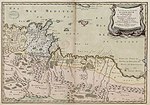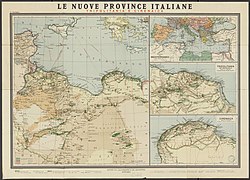Ifriqiya

| History of Tunisia |
|---|
 |
|
|
| History of Algeria |
|---|
| History of Libya | ||||||
|---|---|---|---|---|---|---|
 | ||||||
|
||||||
|
| ||||||
Ifriqiya (
To the south, Ifriqiya was bounded by the semi-arid lands and salt marshes named el-Djerid. The northern boundary fluctuated from as far north as Sicily to the North African coastline, and the western boundary usually reached Béjaïa. The capital was briefly Carthage, then Qayrawan (Kairouan), then Mahdia, then Tunis.[6] The Aghlabids, from their base in Kairouan, initiated the invasion of Southern Italy beginning in 827, and established the Emirate of Sicily, which lasted until it was conquered by the Normans, and the short-lived Emirate of Bari.
History
The province of Ifriqiya was created in 703 CE when the
They were then overthrown by the
Religious divisions paved the way for the
Records of Arabic oral traditions imply that the Muslims first migrated to Africa feeling persecuted in their Arab homeland. However, Muslim military incursions into Africa began around seven years after the death of the Islamic Prophet Muhammad in 632. This campaign into Africa was led by the General Amr ibn al-As and Muslim control of Africa rapidly spread after the initial seizure of Alexandria.
Islam slowly took root in the East African coast due to cross-cultural links established between Muslim traders and the natives of the African coast. The political situation in Islamic Africa was like any other, filled with a chaotic and constant power struggle between movements and dynasties. A key factor in the success of any hopeful party was securing the wealth to fund a push for dominance. One source of great wealth was the lucrative gold-mining areas of
Islam and Africa
A hundred years after the Islamic prophet Muhammad's death, the Arab world had expanded as far as the Indus River, thus extending their empire across Asia, Africa and Europe. Arab merchants wayfarers, and clerics began spreading Islam along the coast and into regions such as Sudan. Islam first took root with Sudanese merchants due to their increased interaction with Muslims. They were then followed by several rulers who in turn converted entire countries, such as Ghana in the eleventh century and Mali in the thirteenth century. Due to the way in which Islam entered the African world, a large part of the rural population remained outside the Muslim realm. The spread of Islam was given new life in the eleventh century when an Islamic fundamentalist group of Berber nomads known as the Almoravids took control of the western Islamic empire. While Islam did spread throughout most of Africa it was a highly erratic process that occurred over a long period of time and was not constant or rapid.[9]
Islamic influences on African societies
In some areas such as Ghana, the presence of Muslims led to the founding of several mosques. It is believed that the
Islamic influence on African art
The Islamic prohibition on the depiction of people and animals was accommodated and integrated into African culture. The charisma of early Muslim clerics in Africa drew swathes of people to Islam. These clerics who were known as marabouts, began producing amulets that contained verses from the Quran. These amulets gradually replaced the role of talismans in African cultures. The emphasis on avoiding representations of living beings reinforced reliance on geometric designs to create intricate patterns for textiles and other crafted goods. Masquerades were another art form that existed in Islamic Africa and they were performed in royal courts in countries such as Mali. However, the most noticeable Islamic impression was left on the architecture of Africa, mosques especially. Islamic civilization crashed,[clarification needed] into Africa and morphed into a hallmark,[clarification needed] of cultural diversity and this is reflected nowhere better than in the multitudes of mosques all across Africa.[9]
Notable people
Constantine the African
Constantine the African was a scholar who was born in Carthage and migrated to Sicily in the 11th century. Constantine traveled through places such as Cairo, India and Ethiopia, and his knowledge of numerous languages helped him interpret many academic texts.
His greatest work came when he joined the Benedictine monastery at Monte Cassino, where he translated over 30 books, including works by Isaac the Jew, one of the most accomplished physicians in the Western Caliphate. He translated Muslim books on Greek medicine from Arabic to Latin, opening Europe up to a wave of medical knowledge they had had little access to before. His book The Total Art is based on The Royal Book by Persian physician Ali ibn al Abbas.[10]
Ibn Khaldun
List of rulers
Conquest phase
- Tripolitana conquered in 643 by Amr ibn al-As, organized as new province with regional capital at Barqa; first governors uncertain.[12]
- Mu'awiya ibn Hudayj, c.665–666 — ruled from Barqa[13]
- Uqba ibn Nafi, 666–674 — conquered south Tunisia (Byzacena), founded Kairouan (670)
- Abu al-Muhajir Dinar, 674–681
- Uqba ibn Nafi, (restored), 681–683 — led cavalcade to Morocco, ostensibly brought the entire Maghreb under submission.
- Uqba killed. Arabs expelled from Byzacena, which was then occupied by Berber chieftain Kusaila, 683–686.
- Zuhayr ibn Qays, 683–689 — initially only Barqa, retook Byzacena in 686.
- Zuhayr killed. Berbers under Kahina retake Byzacena in 689. No clear Arab governor, 689–92
- Hassan ibn al-Nu'man al-Ghassani, 692–703 — initially only Barqa. Captured Carthagein 695 (lost again), then again in 698 (final). Permanent conquest of Ifriqiya, organized as a new province, separately from Egypt, directly under the Umayyad Caliph, with capital at Kairouan.
Umayyad Governors of Ifriqiya
- Musa ibn Nusair al-Lakhmi, 703–715
- (During , 712–715)
- Muhammad ibn Yazid, 715–718
- Ismail ibn Abd Allah ibn Abi al-Muhajir, 718–720
- Yazid ibn Abi Muslim, 720–721
- Muhammad ibn Yazid (restored), 721
- Bishr ibn Safwan al-Kalbi, 721–727
- Ubayda ibn Abd al-Rahman al-Sulami, 727–32
- Uqba ibn Qudama (temporary), 732–734
- Ubayd Allah ibn al-Habhab al-Mausili, 734–41. (Berber Revolt begins 740)
- Kulthum ibn Iyad al-Qushayri, 741
- Balj ibn Bishr al-Qushayri (de jure, in Córdoba) and Abd al-Rahman ibn Uqba al-Ghifari (de facto, in Kairouan), 741–42
- Handhala ibn Safwan al-Kalbi, 742–44
Fihrid Emirs of Ifriqiya
- (Independence from Caliphate: Berber statelets in Fihridcoup d'état in Kairouan, 745)
- Abd al-Rahman ibn Habib al-Fihri, 745–755.
- Ilyas ibn Habib al-Fihri, 755
- Habib ibn Abd al-Rahman al-Fihri, 755–57
Kharijite rulers
- (Fihrid Ifriqiya conquered by Nafusain Tripoli)
- Asim ibn Jamil al-Warfajumi (Sufrite), 757–758
- Abd al-Malik ibn Abi 'l-Jad al-Waranjumi (Sufrite), 758
- (Ibadites of Tripoli depose Sufrites in Kairouan, 758)
- Ibadite), 758–760
- Ibadite), 760–62
Abbasid governors in Kairouan
- (Nafusa, 762)
- Appointed governors
- governor of Egypt)
- Isa ibn Yussuf al-Khurasani 765
- al-Aghlab ibn Salim at-Tamimi 765–766
- al-Hassan ibn Harb al-Kindi 766–767
- al-Mikhariq ibn Ghuffar 767–768
- Umar ibn Hafs al-Muhallabi768–771
- Habib ibn Habib al-Muhallabi 771
- Umar ibn Hafs al-Muhallabi771
- Ibadirebel)
- Yazid ibn Hatim al-Muhallabi 772–787
- Dawud ibn Yazid ibn Hatim al-Muhallabi 787
- Rawh ibn Hatim al-Muhallabi 787–791
- Nasr ibn Habib al-Muhallabi 791–793
- al-Fadl ibn Rawh ibn Hatim al-Muhallabi 793–795
- Appointed governors
- Harthama ibn Ayan795–797
- Muhammad ibn Muqatil al-Akki, 797–799
- Tammam ibn Tamim al-Tamimi 799–800
- Muhammad ibn Muqatil al-Akki 800
Aghlabid Emirs of Ifriqiya
- Ibrahim I ibn al-Aghlab ibn Salim (800–812)
- Abdallah I ibn Ibrahim(812–817)
- Ziyadat Allah I ibn Ibrahim(817–838)
- al-Aghlab Abu Iqal ibn Ibrahim(838–841)
- Abu 'l-Abbas Muhammad I ibn al-Aghlab Abi Affan(841–856)
- Ahmad ibn Muhammad (856–863)
- Ziyadat Allah II ibn Abil-Abbas(863)
- Abu 'l-Gharaniq Muhammad II ibn Ahmad (863–875)
- Abu Ishaq Ibrahim II ibn Ahmad (875–902)
- Abu 'l-Abbas Abdallah II ibn Ibrahim (902–903)
- Abu Mudhar Ziyadat Allah III ibn Abdallah (903–909)
Fatimid Caliphs in Ifriqiya
- Fatimiddynasty
- Abū l-Qāsim Muḥammad al-Qā'im bi-Amr Allāh(934–946)
- Abū Ṭāhir Ismā'il al-Manṣūr bi-llāh(946–953)
- Abū Tamīm Ma'add al-Mu'izz li-Dīn Allāh (953–975) (transferred to Egyptin 973)
Zirid dynasty rulers of Ifriqiya

- Abul-Futuh Sayf ad-Dawla Buluggin ibn Ziri (973–983)
- Abul-Fat'h al-Mansur ibn Buluggin (983–995)
- Abu Qatada Nasir ad-Dawla Badis ibn Mansur(995–1016)
- Sharaf ad-Dawla Fatimids(1045)
(invasion of the
- Abu Tahir Tamim ibn al-Mu'izz (1062–1108)
- Yahya ibn Tamim (1108–1131)
- Ali ibn Yahya (1115–1121)
- Abul-Hasan al-Hasan ibn Ali(1121–1152)
(Ifriqiyan coast annexed by Norman Sicily (1143–1160))
Norman kings of the Kingdom of Africa (Ifriqiya)

- Roger II of Sicily (1143-1154)
- William I of Sicily (1154-1160)
(All of Ifriqiya conquered and annexed by the
Hafsid governors of Ifriqiya
- Abu Muhammad Abd al-Wahid ibn Abi Hafs (1207–1216)
- Abd-Allah (1224–1229)
- Abu Zakariya(1229–1249)
Hafsid caliphs of Ifriqiya
- Muhammad I al-Mustansir (1249–1277)
- Yahya II al-Watiq (1277–1279)
- Ibrahim I(1279–1283)
- Ibn Abi Umara (1283–1284)
- Abu Hafs Umar I (1284–1295)
- Muhammad I (1295–1309)
- Abu Bakr I (1309)
- Aba al-Baqa Khalid an-Nasir (1309–1311)
- Aba Yahya Zakariya al-Lihyani (1311–1317)
- Muhammad II (1317–1318)
- Abu Bakr II (1318–1346)
- Abu Hafs Umar II (1346–1349)
- Ahmad I (1349)
- Ishaq II (1350–1369)
- Abu al-Baqa Khalid (1369–1371)
- Ahmad II (1371–1394)
- Abd al-Aziz II(1394–1434)
- Muhammad III(1434–1436)
- Uthman(1436–1488)
- Abu Zakariya Yahya (1488–1489)
- Abd al-Mu'min (Hafsid) (1489–1490)
- Abu Yahya Zakariya (1490–1494)
- Muhammad IV (1494–1526)
- Muhammad V (1526–1543)
- Ahmad III (1543–1570)
- Muhammad VI (1574–1574)
- Jafari "Jafari the Clean" Yahya (1574–1581)
- Alem Nafirr (1581)
See also
- Aghlabid
- Zirid dynasty
- Hafsid
- Maghreb
- History of Roman-era Tunisia
- History of early Islamic Tunisia
- History of medieval Tunisia
Notes
- ^ (in French) Article « Ifriqiya » (Larousse.fr).
- ISBN 978-1-84701-063-6.
- ISBN 978-1-4051-5204-4.
- ISBN 978-0-8122-9618-1.
- ^ Valérian, Dominique. "Ifrīqiya". Brill. Retrieved 13 Sep 2021.
- ^ http://en.wikisource.org/wiki/Arabic_Thought_and_Its_Place_in_History : DE LACY O’LEARY, D.D. "ARABIC THOUGHT AND ITS PLACE IN HISTORY" London: KEGAN PAUL, TRENCH, TRUBNER & CO., LTD. / NEW YORK: E. P. DUTTON & CO. (1922), pp. 227-8.
- ISBN 9781118455074
- ^ "The Story of Africa| BBC World Service". www.bbc.co.uk. Retrieved 2018-12-12.
- ^ a b c "Trade and the Spread of Islam in Africa | Essay | the Metropolitan Museum of Art | Heilbrunn Timeline of Art History". www.metmuseum.org. Retrieved 2018-12-12.
- )
- ^ "Ibn Khaldūn | Muslim historian". Encyclopedia Britannica. Retrieved 2018-12-12.
- ^ See chronicles of Ibn Abd al-Hakam and al-Nuwayri for accounts of the conquest.
- Abdallah ibn Sa'adwas governor in Egypt.
- ^ This is primarily covered in the chronicle of al-Nuwayri.
- Ibn Khaldoun (v.2 App. #2(pp.496–549))
- Ibn Khaldoun, v.2
- ^ On the Banu Hillal invasion, see Ibn Khaldoun (v.1).
- ^ Abulafia, "The Norman Kingdom of Africa"
- ^ For an account of the Almohad and Norman conquests of Ifriqiya, see Ibn al-Athir (p.578ff)
- ^ See Ibn Khaldoun (v.2 & 3)
Sources
Chronicles
- Ibn Abd al-Hakam, English trans. by C.C. Torrey, 1901, "The Mohammedan Conquest of Egypt and North Africa", Historical and Critical Contributions to Biblical Science, pp. 277–330. online; French trans. in De la Salle Histoire des Berbères et des dynasties musulmanes de l'Afrique Septentrionale, 1852, v.1, App. 1 (pp. 301–308)
- al-Nuwayri, French trans. in De La Salle, Histoire des Berbères et des dynasties musulmanes de l'Afrique Septentrionale, 1852, v.1, App. 2 (pp. 314–444) (From 647 raid through end of Aghlabids) and 1854, v. 2 App.1 (pp. 483–89) (for Zirids). Italian transl. in M. Amari (1851) Nuova raccolta di scritture e documenti intorno alla dominazione degli arabi in Sicilia, (p.27-163) (Aghlabids only)
- Ibn al-Athir extracts from Kamel al-Tewarikh, French trans. in De La Salle, Histoire des Berbères et des dynasties musulmanes de l'Afrique Septentrionale, 1854, v.2, App.#5, (pp. 573ff)
Secondary
- Julien, C.A. (1931) Histoire de l'Afrique du Nord, vol. 2 – De la conquête arabe à 1830, 1961 edition, Paris: Payot.

